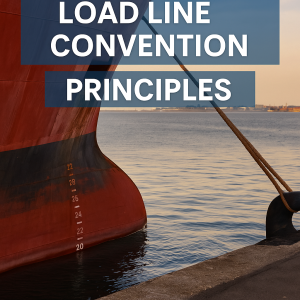Discover the top 6 Load Line Convention principles essential for ship seaworthiness. Learn how freeboard, reserve buoyancy, watertight integrity, structural strength, crew access, and zone loading protect vessels and lives at sea.
Why Load Line Rules Save Lives at Sea
Picture a merchant ship, laden with cargo, buffeted by North Atlantic storms. Amidst the waves, it’s the unsung guardrails of maritime safety — the Load Line Convention principles — that keep the vessel afloat, crew safe, and prevent tragedy. Originally championed by Samuel Plimsoll in the 19th century, these guidelines have evolved through the 1966 Load Line Convention and its 1988 Protocol, setting binding international standards for seaworthiness.
In this detailed, human-focused guide, we unpack the top six principles that every mariner, shipowner, and student must know to ensure safety at sea—whether crossing Atlantic trade routes or navigating coastal waters during seasonal shifts.

Understanding the Load Line Convention Framework
The International Convention on Load Lines, 1966 (LL66) established minimum freeboards based on ship type, size, and operational zones. Amended by the 1988 Protocol and ongoing IMO updates, it governs hull markings, survey schedules, and load line certificates—fortifying both commercial efficiency and safety.
1. Freeboard—Protect Airline to the Sea
Freeboard is the vertical distance from the waterline to the freeboard deck. LL66 sets minimum freeboards to preserve reserve buoyancy, stability, and stress resistance .
Analogous to leaving enough room in a suitcase—overfill past the line, and essential gear may be lost—exceeding freeboard limits may flood hatches in rough seas. The freeboard adjusts for zones (summer, winter, tropical) to reflect different seasonal hazards .
2. Reserve Buoyancy—Float Even When Flooded
Load Line rules ensure a vessel has buoyant volume to stay afloat even when partially flooded. This safety margin is vital during hull damage or free-surface flooding events—and protected via reserved freeboard space .
Case in point: the tragic sinking of the ferry MV Sinar Bangun in Lake Toba was linked to overloading, effectively erasing reserve buoyancy and resulting in capsizing .
3. Watertight Integrity Below the Freeboard Deck
The Convention mandates watertight features below the freeboard deck—closing devices on doors, hatches, freeing ports, and scuppers defend against water intrusion during severe sea conditions .
A case study: MV Lestari Maju sank after waves entered through low openings and absent freeing ports, showing how violations of watertight integrity directly threaten seaworthiness .
4. Adequate Structural Strength
LL66 requires hull and superstructure strength capable of withstanding hull girder bending, hogging, and sagging stresses. Classification societies (LR, DNV, ABS, BV) ensure compliance through scantlings and surveys.
The loss of SS El Faro and MV Derbyshire relate to insufficient structures amid heavy seas. Ensuring structural integrity under extreme loading remains critical.
5. Safe Crew Access
Crew access and safety features—such as guardrails, adequate lighting, and gangway designs—must remain safe even under adverse conditions. These rules reflect broader human-centered maritime safety principles .
Maintaining freeboard also ensures access ladders stay above waterline, avoiding accident risks during heavy seas—vital for emergency egress and day-to-day functionality.
6. Load Line Marking, Certification, and Survey Standards
The iconic Plimsoll mark encodes the load line and letters for seasonal zones. It must remain visible and maintained. Ships require periodic surveys—initial, annual, intermediate, and renewal—to hold a valid International Load Line Certificate (ILLC)
Missing or altered load line marks contributed to historical disasters such as SS Eastland, where overloading caused instability and sinking.
In Practice: How These Principles Prevent Disasters
-
MV Sewol disaster (2014): Excess cargo, modifications, and omitted watertight features removed freeboard and reserve buoyancy—leading to tragic capsize .
-
Kim Nirvana-B (2015): Overloading and negligence caused ferry capsizing—reinforcing the need for load line compliance .
These tragedies reflect broken adherence to Load Line powerhouses—overloading, missing watertight protections, and loss of reserve buoyancy.
FAQ
Q1: What sizes of ships are affected by the Load Line Convention?
Ships ≥24 m in length or ≥150 GT on international voyages must comply. Exemptions include warships, small yachts, and fishing boats
Q2: Why are seasonal load lines important?
They allow for changing sea conditions—winter zones demand greater freeboard due to higher wave risk, while tropical zones permit lower freeboards
Q3: What if a load line certificate lapses?
Voyaging without a valid ILLC can lead to detainment, insurance issues, port denial, or civil prosecution.
Q4: How often must surveys be done?
Initial, annual (±3 months), renewal every five years, and intermediate or after major repairs
Q5: Can load line marks be submerged due to sag?
No. Submersion due to sag weakens regulatory effect; load line marks must remain visible and at assigned load line location
Conclusion: Load Line Compliance Anchors Ship Safety
These six Load Line Convention principles—freeboard, reserve buoyancy, watertight integrity, structural strength, crew access, and certification—form the foundation of seaworthiness. They protect against overloading, flooding, structural failures, and crew hazards.
Recent cases—from Sewol to Sinar Bangun—vividly illustrate the consequences of neglecting these principles. Meanwhile, IMO updates continue to refine survey protocols and structural guidelines, ensuring evolving ship types remain safe.
For shipowners, mariners, and regulators, Load Line compliance isn’t a technical box to tick—it’s a living commitment to safeguarding lives, cargo, and marine environments across the world’s oceans.
References
-
IMO. (n.d.). International Convention on Load Lines, 1966
-
The Master Mariner. (n.d.). Principles of the Load Line Convention themastermariner.com
-
Marine Insight. (2024). Introduction to Ship Load Lines marineinsight.com
-
UK MCA. (2023). International Load Line Policy Notes dco.uscg.mil
-
Pirie & Smith. (2021). USV Load Line Exemptions Guide piriesmith.co.uk
-
NTSB. (2017). Sinking of SS El Faro ntsb.gov
-
ICS Class. (2015). Derbyshire Case Study surveyors.icsclass.org
-
Wikipedia. (2025). MV Sinar Bangun, MV Sewol, SS Eastland en.wikipedia.org
-
LeanBlog. (2023). Plimsoll Load Line History

